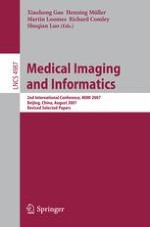This series constitutes a collection of selected papers presented at the International Conference on Medical Imaging and Informatics (MIMI2007), held during August 14–16, in Beijing, China. The conference, the second of its kind, was funded by the European Commission (EC) under the Asia IT&C programme and was co-organized by Middlesex University, UK and Capital University of Medical Sciences, China. The aim of the conference was to initiate links between Asia and Europe and to exchange research results and ideas in the field of medical imaging. A wide range of topics were covered during the conference that attracted an audience from 18 countries/regions (Canada, China, Finland, Greece, Hong Kong, Italy, Japan, Korea, Libya, Macao, Malaysia, Norway, Pakistan, Singapore, Switzerland, Taiwan, the United Kingdom, and the USA). From about 110 submitted papers, 50 papers were selected for oral presentations, and 20 for posters. Six key-note speeches were delivered during the conference presenting the state of the art of medical informatics. Two workshops were also organized covering the topics of “Legal, Ethical and Social Issues in Medical Imaging” and “Informatics” and “Computer-Aided Diagnosis (CAD),” respectively.
